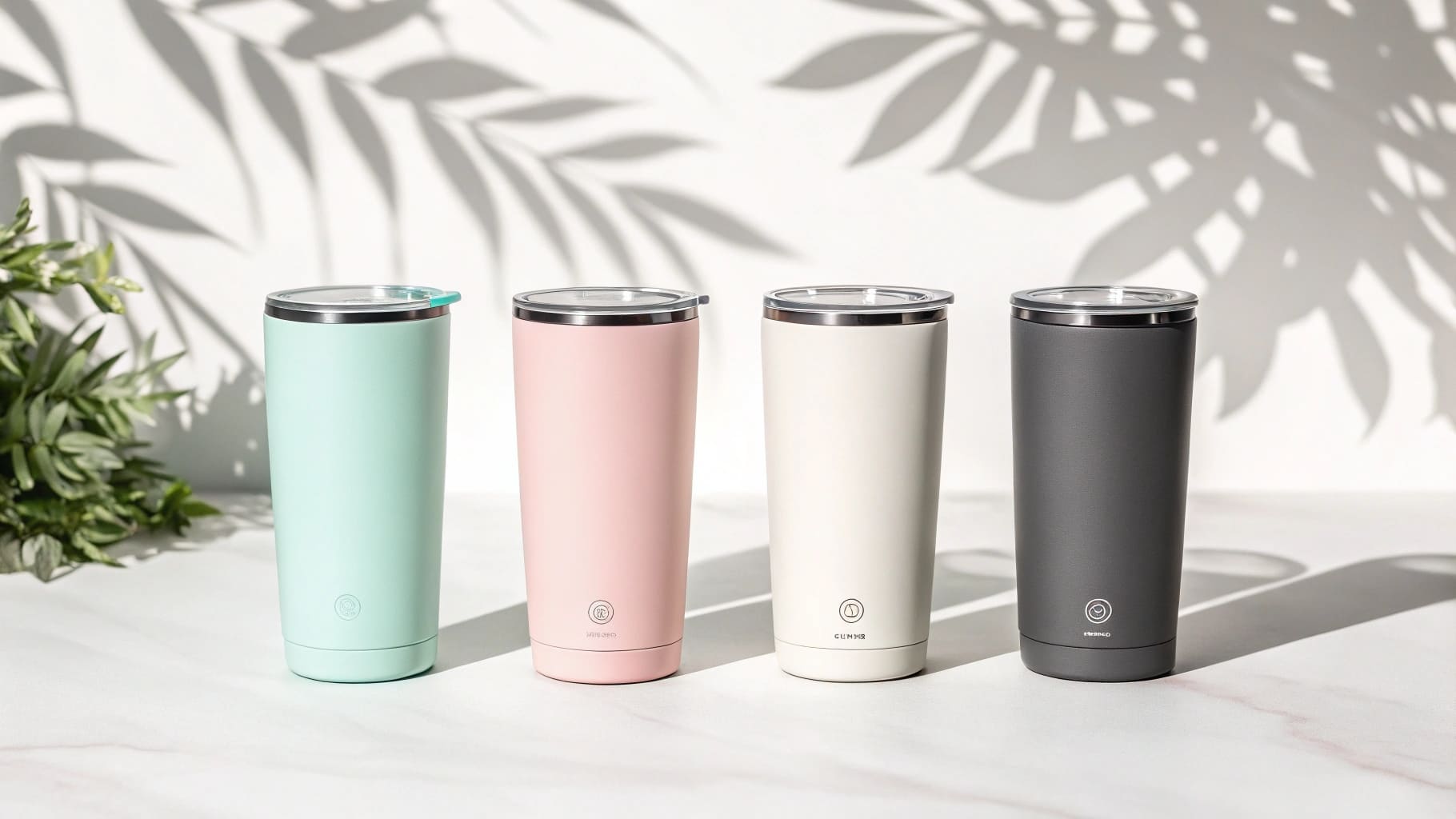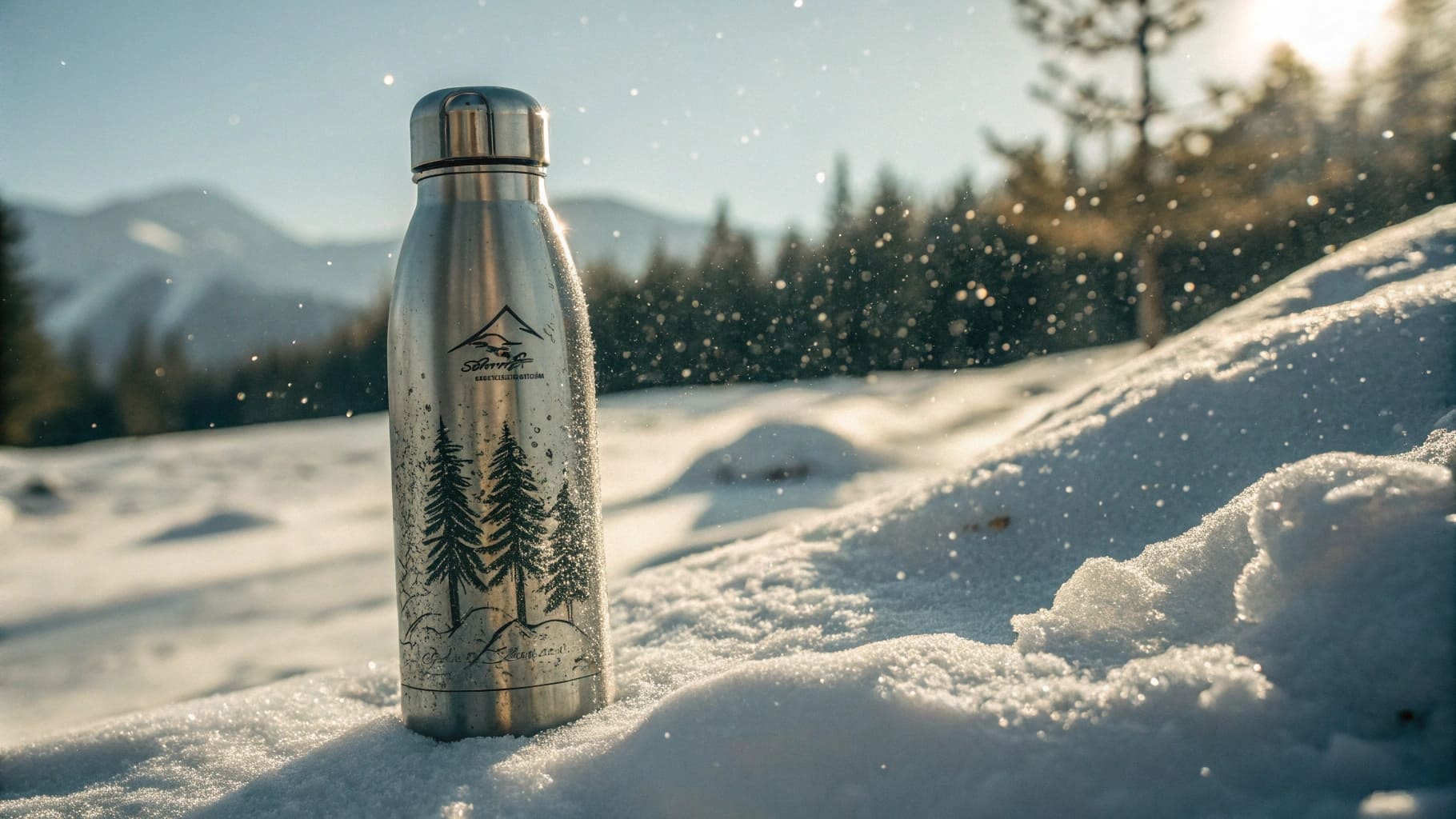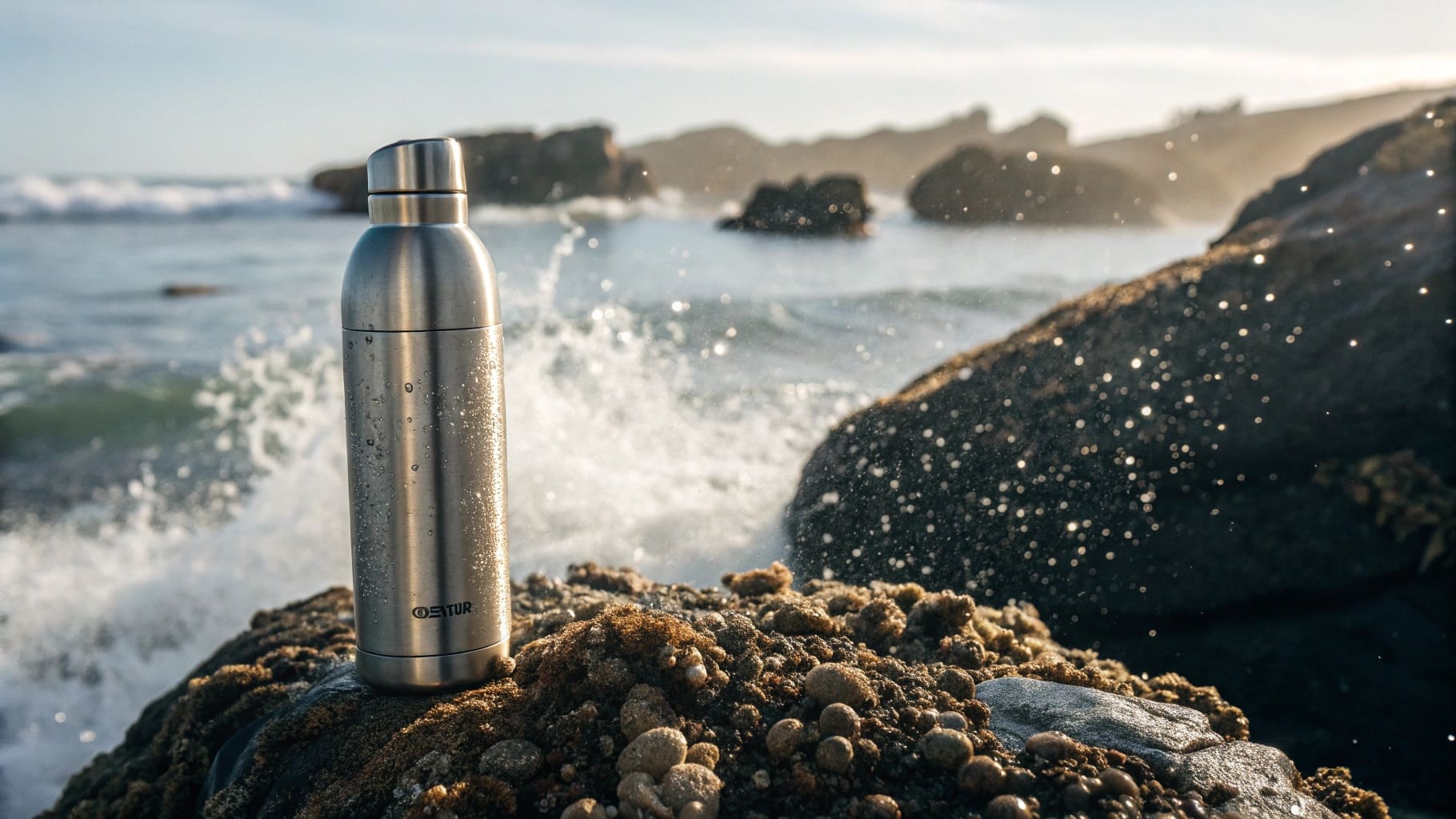Tired of bottles soaking your bag or leaving wet rings? It’s frustrating. Discover the key features that make a stainless steel bottle truly reliable and mess-free for your customers.
The best stainless steel bottles that prevent leaks and sweating combine a high-quality, secure lid system with double-wall vacuum insulation. This ensures contents stay in and condensation stays away, offering a superior user experience.

Finding the perfect stainless steel bottle can feel like a quest. You want something durable, safe, and, most importantly, something that won't create a mess. As a B2B supplier, I know that delivering on these expectations is key to customer satisfaction and protecting your brand's reputation. Let's explore what makes a bottle genuinely leak-proof and sweat-proof, so you can make informed purchasing decisions. We need to look beyond just the material and consider the entire design.
Is stainless steel water and sweat proof?
Worried your stainless steel bottle might get damaged by water or condensation? It's a common concern. Let me assure you about the resilience of quality stainless steel.
Yes, high-grade stainless steel is inherently water-resistant and will not be damaged by "sweat" (condensation). The material itself is robust; "sweating" is about bottle construction, not a material flaw.

When we talk about stainless steel bottles, we're usually referring to food-grade stainless steel1, often types 304 (also known as 18/8) or sometimes 316. I've handled countless samples and production runs of both. These materials are chosen for very specific reasons.
- Corrosion Resistance: The "stainless" part comes from chromium. When chromium is present in steel (typically at least 10.5%), it reacts with oxygen to form a thin, invisible, and very stable passive layer of chromium oxide on the surface. This layer protects the iron in the steel from rusting. It also reforms if scratched, which is a fantastic property.
- "Sweat" is Just Water: The condensation, or "sweat," that forms on a cold bottle is simply water from the surrounding air. As I often explain to clients like Mark Shenng, who are very quality-conscious, this pure water does not harm the stainless steel itself. My insight here is that stainless steel, particularly grades like 304 or 316, is inherently robust and resistant to corrosion; condensation (water) will not damage it. Think of stainless steel sinks or cookware; they are constantly exposed to water without issue.
The critical distinction to make, especially for procurement officers, is between the material's properties and the bottle's overall construction. A single-wall stainless steel bottle will sweat if it's cold inside and the air outside is humid. This isn't the steel failing; it's physics. The steel itself remains undamaged. This understanding helps in selecting the right product type for specific needs and managing end-user expectations effectively.
| Feature | Stainless Steel 304 (18/8) | Stainless Steel 316 | Implication for Bottles |
|---|---|---|---|
| Composition | ~18% Chromium, ~8% Nickel | ~16-18% Cr, ~10-14% Ni, ~2-3% Molybdenum | Both highly corrosion-resistant. |
| Corrosion | Excellent general corrosion resistance2 | Enhanced resistance, esp. to chlorides | 304 is standard; 316 offers more for harsh environments. |
| Food Safety | Widely accepted as food-grade | Also food-grade | Both safe for beverages. |
| "Sweat" Impact | Unaffected by water condensation | Unaffected by water condensation | Condensation does not degrade the material. |
What kind of water bottle doesn't sweat?
Do you find that annoying layer of condensation on your cold drink bottle a real nuisance? It makes surfaces wet and the bottle slippery. There's a specific design that solves this.
Double-wall vacuum insulated water bottles are the type that don't sweat. This construction creates an airless barrier, preventing the cold from transferring to the outer surface and forming condensation.

The "sweating" issue, or condensation, is purely a matter of temperature difference and thermal transfer. If you're like me, you've probably seen customers complain about this. I once had a potential client, a startup boss, who was very enthusiastic but concerned about this very point for his new branded merchandise line.
Here's how I explain it:
- Single-Wall Bottles: Imagine a simple, single layer of stainless steel. If you fill it with ice-cold water, the outer surface of that steel will also become very cold. When warm, moist air from the surrounding environment comes into contact with this cold surface, the air cools down. Cool air can't hold as much moisture as warm air, so the excess moisture condenses into tiny water droplets on the bottle. This is the "sweat." My insight is that a single-wall stainless steel bottle filled with a cold liquid will indeed sweat.
- Double-Wall Vacuum Insulated Bottles: This is where the clever engineering comes in. These bottles have two layers of stainless steel: an inner wall and an outer wall. The air between these two walls is pumped out during manufacturing, creating a vacuum. A vacuum is an excellent insulator because it drastically reduces heat transfer by conduction and convection.
- No Conduction/Convection: Since there's very little air (or no air ideally) between the walls, the cold temperature from your drink in the inner wall cannot easily transfer to the outer wall.
- Outer Wall Stays at Room Temperature: Because the outer wall doesn't get cold, the surrounding warm, moist air doesn't cool down when it touches the bottle. Therefore, no condensation forms.
The solution is double-wall vacuum insulation. This construction creates a barrier, preventing the cold from the inner wall from reaching the outer wall, thus stopping condensation from forming. For any business, like those in America or Europe looking to import, offering a sweat-free bottle is a significant upgrade in user experience. It’s a feature I always highlight because it directly translates to higher perceived value.
| Bottle Type | Construction | Sweating (Condensation) | Temperature Retention | Typical Use Case |
|---|---|---|---|---|
| Single-Wall Stainless | One layer of steel | Yes, with cold liquids | Poor | Basic hydration, room temp |
| Double-Wall (No Vacuum) | Two layers, air gap | Reduced, but possible | Fair | Some insulation, less common |
| Double-Wall Vacuum | Two layers, vacuum seal | No | Excellent | Hot/cold beverages, premium feel |
Does sweat damage stainless steel?
You might see condensation on your bottle and wonder if this "sweat" could eventually harm the stainless steel. It's a fair question, especially when investing in quality. The answer is reassuring.
No, the "sweat" or condensation on a bottle is simply pure water from the air. This water does not damage high-quality stainless steel, which is specifically chosen for its corrosion-resistant properties.

It’s important to be very clear about what we mean by "sweat" in this context. For bottles, it refers to condensation – water that has condensed from the ambient air onto a cold surface. This is quite different from human perspiration, which contains salts and other compounds.
My experience in sourcing and manufacturing these products for years has shown me that condensation (water) will not damage it [stainless steel]. Here’s a more detailed breakdown:
- The Nature of Condensation: The water that forms on the outside of a cold bottle is H₂O, plain and simple. It's usually quite pure, as it's distilled from the humidity in the air.
- Stainless Steel's Protective Layer: As mentioned earlier, stainless steel contains chromium. This chromium forms a passive, self-repairing chromium oxide layer on the surface. This layer is highly resistant to oxidation (rust) and general corrosion. Pure water, like condensation, is not aggressive enough to break down this protective layer on good quality stainless steel (like 304 or 316 grade).
- Quality Matters: The key here is "good quality stainless steel." If a manufacturer were to use a very low grade of steel with insufficient chromium or impurities, then yes, prolonged exposure to moisture could potentially lead to issues. This is why, as a B2B supplier (Icobottle), we are meticulous about material certification and testing. For buyers like Mark Shenng, who focus on quality inspection and certification, this is a critical point. Certificate fraud is a real pain point, and we ensure our documentation is always legitimate.
Consider this: stainless steel is used for kitchen sinks, surgical instruments, and marine fittings – all applications where they are frequently exposed to water and moisture, often far more aggressive than simple condensation. The material is designed for this. So, while the presence of sweat might be annoying (which is solved by double-wall insulation), the sweat itself is not a threat to the integrity of a well-made stainless steel bottle.
Why is a Quality Lid Crucial for Preventing Leaks in Stainless Steel Bottles?
Ever had a bottle leak inside your bag, ruining documents or electronics? It's a nightmare. This almost always comes down to one critical component: the lid.
A quality lid is paramount. It prevents leaks through precision-engineered threads and effective, food-grade silicone seals, ensuring a tight and reliable closure for your customers' peace of mind.

When procurement officers from large companies or startup bosses evaluate stainless steel bottles, the "leak-proof" claim is high on their checklist. And rightly so. A leaking bottle leads to dissatisfied end-users and can damage a brand's reputation. From my years at Icobottle, dealing with product development and quality control, I can tell you that leaking is almost always a function of lid design and manufacturing precision3—specifically, the quality of threads and the effectiveness of seals, often made from food-grade silicone. A well-engineered lid system is paramount for a leak-proof4 experience.
Let's break down the crucial elements:
-
Thread Design and Manufacturing:
- Precision: The threads on the bottle neck and inside the lid must match perfectly. This requires precise molding or machining. Even slight imperfections can create channels for liquid to escape, especially under pressure or movement.
- Thread Profile: The shape and depth of the threads matter. Some designs offer a more secure engagement than others.
- Material Integrity: The threads must be robust and not prone to stripping or warping over time.
-
The Seal (Gasket):
- Material: The most common and effective material for seals in food-grade applications is silicone. Food-grade silicone is flexible, durable, temperature-resistant, and doesn't impart flavors. It also creates an excellent airtight and watertight seal.
- Design and Placement: The seal (often an O-ring or a flat gasket) must be correctly designed to compress evenly when the lid is tightened. Its placement within the lid is critical to ensure it engages properly with the bottle's rim or inner neck.
- Durability: The seal needs to withstand repeated opening and closing, cleaning, and exposure to various liquids without degrading, cracking, or deforming. I recall a batch of samples where the supplier used a cheaper TPE seal; it hardened and cracked after just a few uses during our internal testing. We insisted on food-grade silicone5 for the final production.
-
Overall Lid Construction:
- Robustness: The lid itself should be made from durable materials (e.g., BPA-free plastic, stainless steel) that won't crack or break easily.
- Ease of Use: While being secure, the lid should also be reasonably easy to open and close.
For B2B buyers, verifying the lid quality is essential. This involves checking samples, understanding the materials used, and even inquiring about the manufacturing tolerances. It’s an area where cutting corners can lead to significant downstream problems. A slightly higher investment in a superior lid design can save a lot of headaches and protect the brand.
| Lid Component | Importance for Leak Prevention | Common Material Choices | What to Look For |
|---|---|---|---|
| Threads | Creates the primary mechanical closure; precision is key. | Stainless Steel, BPA-free Plastic | Smooth, well-defined, no defects, easy engagement. |
| Seal/Gasket | Provides the watertight barrier; compression is vital. | Food-grade Silicone | Proper fit, no nicks/tears, good elasticity. |
| Lid Body | Houses the seal and threads; must be durable. | BPA-free Plastic, Stainless Steel | Sturdy construction, no cracks. |
Conclusion
The best stainless steel bottles combine double-wall vacuum insulation to stop sweat and a meticulously engineered, high-quality lid with effective seals to prevent any leaks. This ensures customer satisfaction.
-
Discover the significance of food-grade stainless steel for safety and health in food and beverage containers. ↩
-
Learn about corrosion resistance in stainless steel to appreciate its longevity and suitability for various applications. ↩
-
Discover the key elements that ensure high-quality lid design, which is vital for preventing leaks and ensuring customer satisfaction. ↩
-
Learn about the essential features and tests that define a leak-proof bottle, helping you make informed purchasing decisions. ↩
-
Explore the advantages of food-grade silicone, known for its durability and effectiveness in creating airtight seals, crucial for leak-proof bottles. ↩

